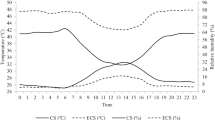Abstract
Twenty-seven groups of pigs of three each were raised in controlled-environment houses for 12 to 14 weeks. Three levels of humidity (% RH) were compared at temperatures of 22°, 28° and 33°C. Rate of gain and feed consumption decreased with increasing humidity at any of these temperatures, with effect of humidity increasing with increasing temperature. The rate-of-gain data were consistent with rates predicted from analysis of the effect of humidity on evaporative heat loss with respiration. Humidity had little effect on feed efficiency, rectal temperature, or skin temperature.
Zusammenfassung
Es wurde der Einfluss von 3 verschiedenen Feuchtigkeits-bedingungen (%RF) bei 22°, 28° und 33°C auf die Gewichtszunahme und den Futterverzehr von Schweinen untersucht, die in 27 Gruppen zu je 3 Tieren aufgeteilt waren. Bei jeder Temperatur führte die Erhöhung der Feuchtigkeit zur Senkung des Futterverzehrs und der Gewichtszunahme. Die Zuwachswerte fielen zusammen mit den vorausgesagten Werten für den evaporativen Wärmeverlust bei der Atmung. Die Feuchtigkeit hatte nur eine geringe Wirkung auf die Futterausnutzung, die Rektaltemperatur und die Hauttemperatur.
Resume
On a recherché les répercussions de 3 degrés d'humidite (% hum. rélative) différentes par 22°, 28° et 33°C sur l'augmentation de poids et la consommation alimentaire de procs. Ces derniers étaient répartis en 27 groupes de 3 animaux chacun. Pour toutes les températures, une augmentation de l'humidité se traduit par une diminution de l'alimentation et de la prise de poids. Les valeurs de croissance correspondent aux valeurs calculées de la perte de chaleur due à l'évaporation par les processus respiratoires. L'humidité n'a eu que peu d'incidence sur l'utilisation des rations alimentaires ou sur les températures rectale et cutanée.
Similar content being viewed by others
References
HEITMAN, H., Jr., KELLY, C.F. and BOND, T.E. (1958): Ambient air temperature and weight gains in swine. J.An.Sci., 17: 62–67.
MORRISON, S.R., HEITMAN, Jr., BOND, T.E. and FINN-KELCEY, P. (1966): The influence of humidity on growth rate and feed utilization of swine. Int.J.Biometeor., 10: 163–168.
MORRISON, S.R., BOND, T.E. and HEITMAN, H., Jr. (1968): Effect of humidity on swine at high temperature. Trans.Amer.Soc.Agric.Engr., 11: 526–528.
MORRISON, S.R.,HAHN,L. and BOND, T.E. (1969): Summer production losses in swine. USDA Prod.Res.Rep.No.
ROBINSON, K. and LEE, D.H.K. (1941): Reaction of the pig to hot atmospheres. Proc.Royal Soc.Qd., 53: 135–158.
Author information
Authors and Affiliations
Rights and permissions
About this article
Cite this article
Morrison, S.R., Heitman, H. & Bond, T.E. Effect of humidity on swine at temperatures above optimum. Int J Biometeorol 13, 135–139 (1969). https://doi.org/10.1007/BF01552734
Received:
Issue Date:
DOI: https://doi.org/10.1007/BF01552734




